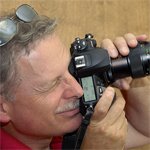I've been reading Martin Evening's LR book and am learning a ton about it. For example, when you see your images the first time around in LR they may appear dark but still have a full histogram representation. This is due to a 1.0 linear gamma as the file comes directly from digital camera RAW files. (Explains why the LCD review on the camera is never the same too!) What this means is that if displayed as-is, color and exposure adjustments would be overly sensitive with very tightly packed midrange and very stretched out highlight characterization. To view your images more like the human eye, LR uses sRGB-based controls which make subtle changes possible without overdoing anything - especially in the Exposure and Blacks sliders.
Now, before you freak out and assume this must mean all your fine artistic images have been squeezed into an inferior color space - they're not. In fact, all images can be set to open in either a 16-bit RGB Prophoto or Adobe RGB color space - and kept there until final output is determined. The interface simply utilizes an sRGB 'response curve' to control editing.
So your saved master RAW files are just as exquisite as they were when first captured. But where are you taking them? Well, you decide of course, but Martin suggests we use external drives to avoid internal drive/CPU failure catastrophes and maintain portability - unless you have those fancy plug-in hard drives on your tower. I'm doing so with a 160GB Maxtor I picked up from Buy.com for under $100.
Overall, LR is becoming a well used application on all my images. A quick review and flagging of keepers, followed by color corrections/preset treatments and/or cropping, and a web gallery for immediate distribution to friends and business interests is a simple routine now. Here's where LR really shines. Setup your viewing to scroll through and flag the keepers - use the arrows to navigate and press P to flag or U to unflag. Then perform an initial color adjustment to a good representative image. Select similar frames you want to adjust and use Synch to add that adjustment to all the others. You can still adjust individual frames but this is where LR saves you a bunch of time. You can Synch everything from color edits, cropping, sharpening, noise reduction - the whole scrape or just what adjustments you want to.
After that it's time to make a Collection(s) that will segment the images for printing or web gallery display. You should be able to LR 400 images in a couple hours once you get comfy with this woprkflow. Most of my time was getting the workflow understood and learning keyboard shortcuts.
I PP'd a recent wedding assignment (650+ images) in about four hours - no record but well under my previous methodology- and I'll be twice as fast the next time. I downloaded, reviewed, flagged, color corrected, cropped, and output a web gallery of my Labor Day weekend Boomsday images (350+) in about two hours - I was rockin'!
I can see my use of PS CS quickly being reserved for elaborate web/graphic design and complex image edits (clipping paths, serious cloning, etc.) from here on out - it's just too laborious to use all the time anymore.
Mule
Tuesday, September 4, 2007
Subscribe to:
Post Comments (Atom)



No comments:
Post a Comment